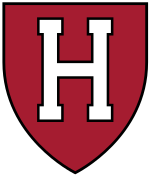|
1919–20 Harvard Crimson men's ice hockey season
The 1919–20 Harvard Crimson men's ice hockey season was the 22nd season of play for the program. SeasonAfter a successful return in 1919, the hockey team had high hopes for a return to glory in the first full season since the end of World War I. First, however, they would have to overcome a few difficulties. Alfred Winsor, the coach who had instilled a tremendous defensive system and led the team to 7 intercollegiate championships, would not return to the program. The team decided to hire another Crimson grad with William Henry Claflin Jr. becoming the second coach in team history.[1] Secondly, with the Boston Arena still undergoing repairs due to a fire, the university would have to find a new home for the year. With the St. Nicholas Rink now closed for hockey and the opening of the Philadelphia Ice Palace delayed, Harvard was able to secure the small Cambridge Ice Pavilion for many of its early games.[2] Due to the small size of the rink, all games that took place there were restricted to six players on each side, rather than the normal seven for college games. Additionally, many of the game were played using three 15-minute periods rather than two 20-minute halves. The changes known well ahead of time but the team may still have been put off by the strangeness in their games because the Crimson lost the first three games of their season. Fortunately, none were to other colleges and when they opened the inaugural Triangular Hockey League season against Yale, Harvard was able to overcome a 3-goal middle frame from the Elis with one of their own in the third to win the game 5–4.[3] The next game against the Dartmouth Club saw a return to 20-minute halves, but the match progressed similarly with the opponents building a multi-goal lead that Harvard was just able to overcome and claim victory.[4] Three nights later Harvard downed the official team from Dartmouth and were beginning to get used to the style of play necessitated by the size of the Pavilion. By the time Harvard played Tufts they had rounded into form and dominated the Jumbos 8–0 while using their alternates for most of the game.[5] The offensive heart of the team, Edward Bigelow, returned from an injury just in time for the first game against Princeton. After the Tigers opened the scoring, Bigelow tied the game and set up an offensive deluge that resulted in a 4–1 lead after the first period. The teams played tighter in the final two frames but Harvard's defense was up to the task and the Crimson responded to every Tiger goal to take the game by a final score of 6–3.[6] A 5-goal game from Bigelow paced the team in their 8–0 win over MIT[7] But the team was far more impressive in their 4–3 win over the Boston All Stars. Even with several fluky goals, and a bit of controversy over the game-winner,[8] Harvard was able to run their winning streak to 7 games at the end of the most strenuous stretch of their season. Harvard won one more home game before preparing to head south and play Yale at the Philadelphia Ice Palace. With the game played on a surface even larger than modern Olympic rinks, Harvard was dominant throughout the game, their first 7-on-7 match of the season. Only through the brilliant goaltending of Walker was Harvard's score limited to 3 goals.[9] The win gave the season series to Harvard as well as the intercollegiate championship. The Crimson still had to finish their series with Princeton, but the Tigers' record was so poor that even if they were to win the series Harvard would still possess the crown for 1920. In the end, however, Princeton proved no match for Harvard and the Crimson were able to post their biggest victory over the Tigers to that point with a 10–1 win. Captain Walker left the game late with a broken nose but that minor injury couldn't detract from the overpowering performance that cemented Harvard's ninth Intercollegiate Championship.[10] Harvard was reported as both the Intercollegiate Champion and Eastern Intercollegiate Champion at the time.[11] While the midwestern schools had just begun their programs and they would not regularly play the eastern teams for several years, none played more than a handful of games and most matches were not intercollegiate contests. This left Harvard with a claim for a unified National Championship, the last such claim until 1948. Roster
Standings
Schedule and results
References
|
|||||||||||||||||||||||||||||||||||||||||||||||||||||||||||||||||||||||||||||||||||||||||||||||||||||||||||||||||||||||||||||||||||||||||||||||||||||||||||||||||||||||||||||||||||||||||||||||||||||||||||||||||||||||||||||||||||||||||||||||||||||||||||||||||||||||||||||||||||||||||||||||||||||||||||||||||||||||||||||||||||||||||||||||||||||||||||||||||||||||||||||||||||||||||||||||||||||||||||||||||||||||||||||||||||||||||||||||||||||||||||||||||||||||||||||||||||||||||||||||||||||||||||||||||||||||||||||||||||||||||||||||||||||||||||||||||||||||||||||||||||||||||||||||||||||||||||||||||||||||||||||||||||||||||||||||||||||||||||||||||||||||||||||||||||||||||||||||||||||||||||||||||||||||||||||||||||||||||||||||||||||||||||||||||||||||||||||||||||||||||||||||||||||||||
Portal di Ensiklopedia Dunia
